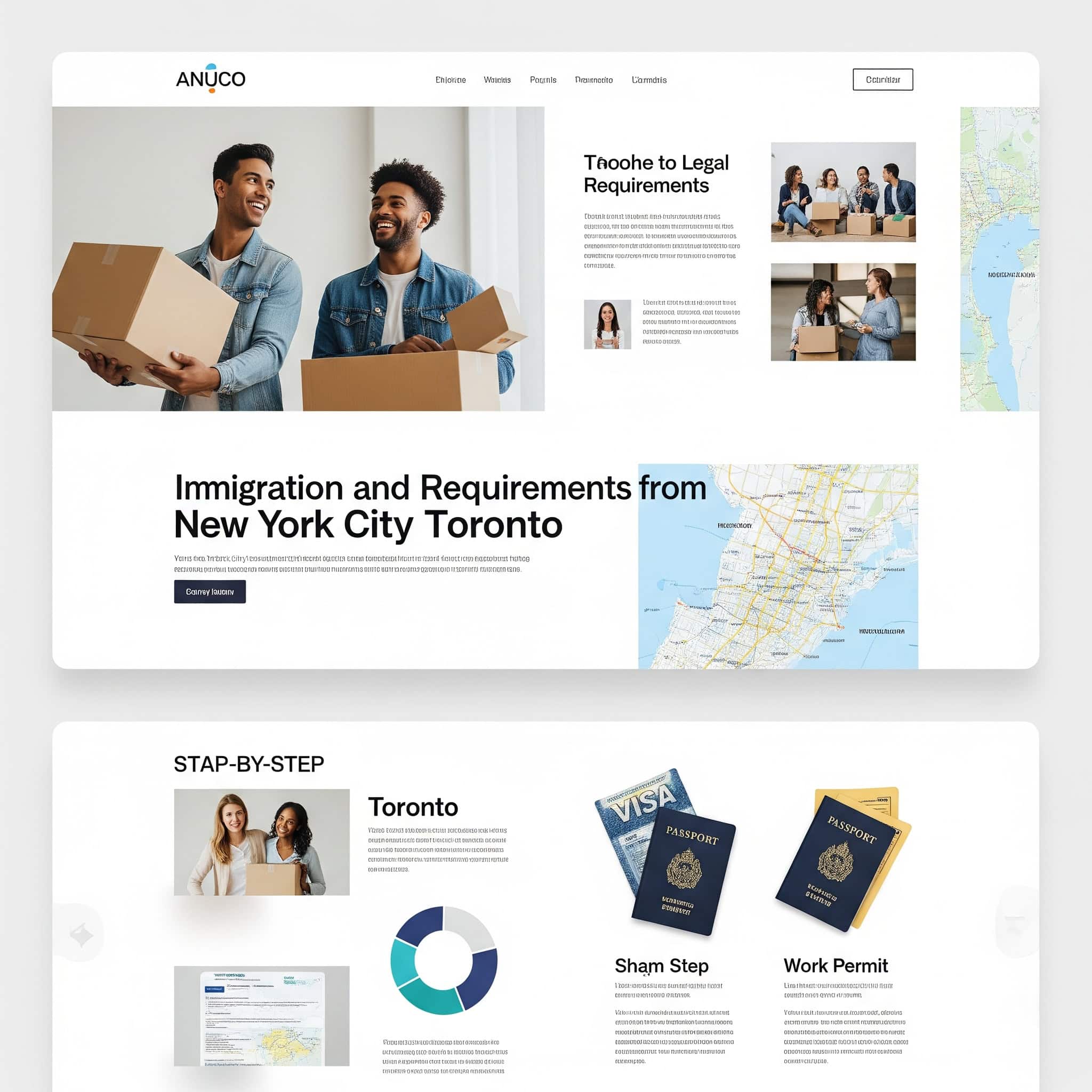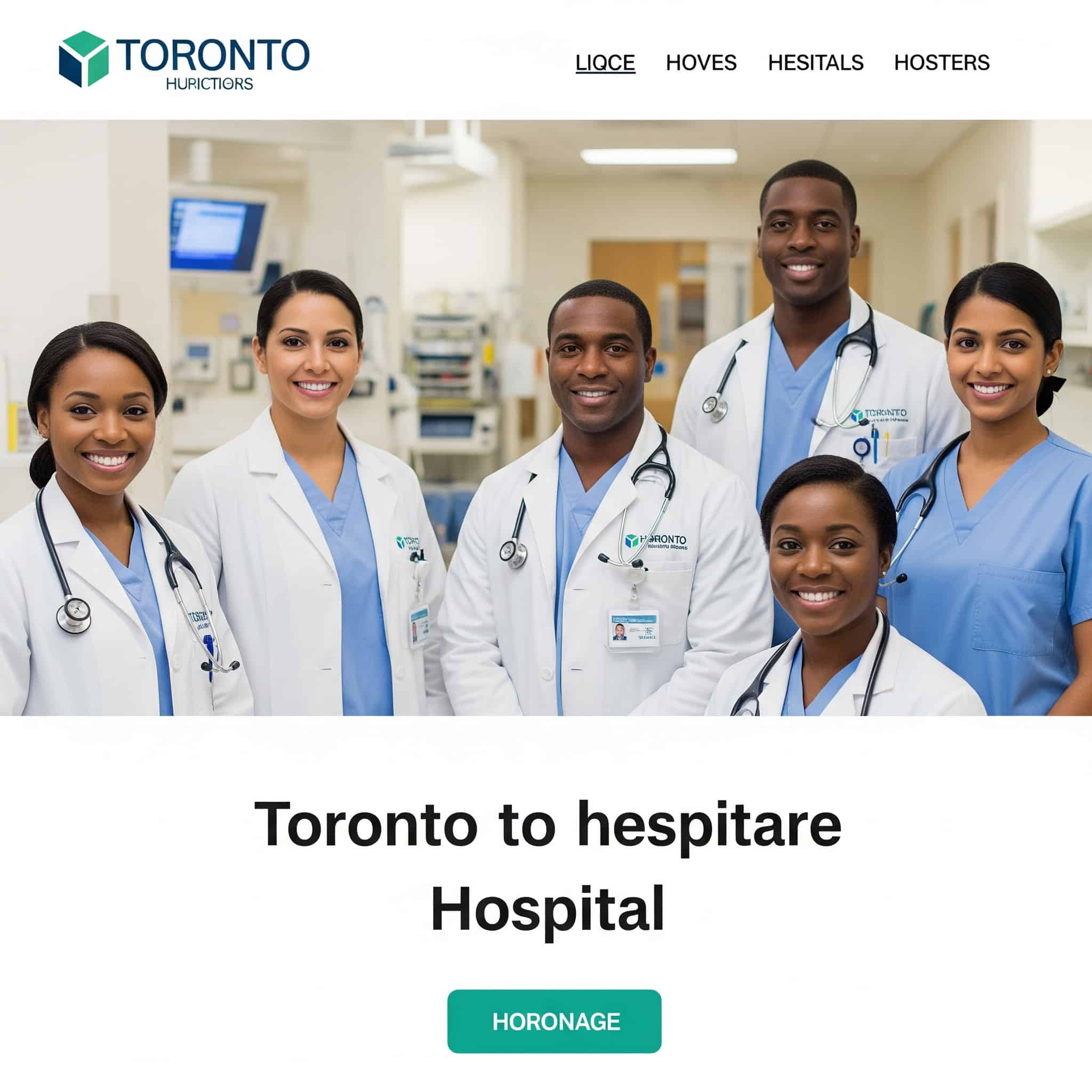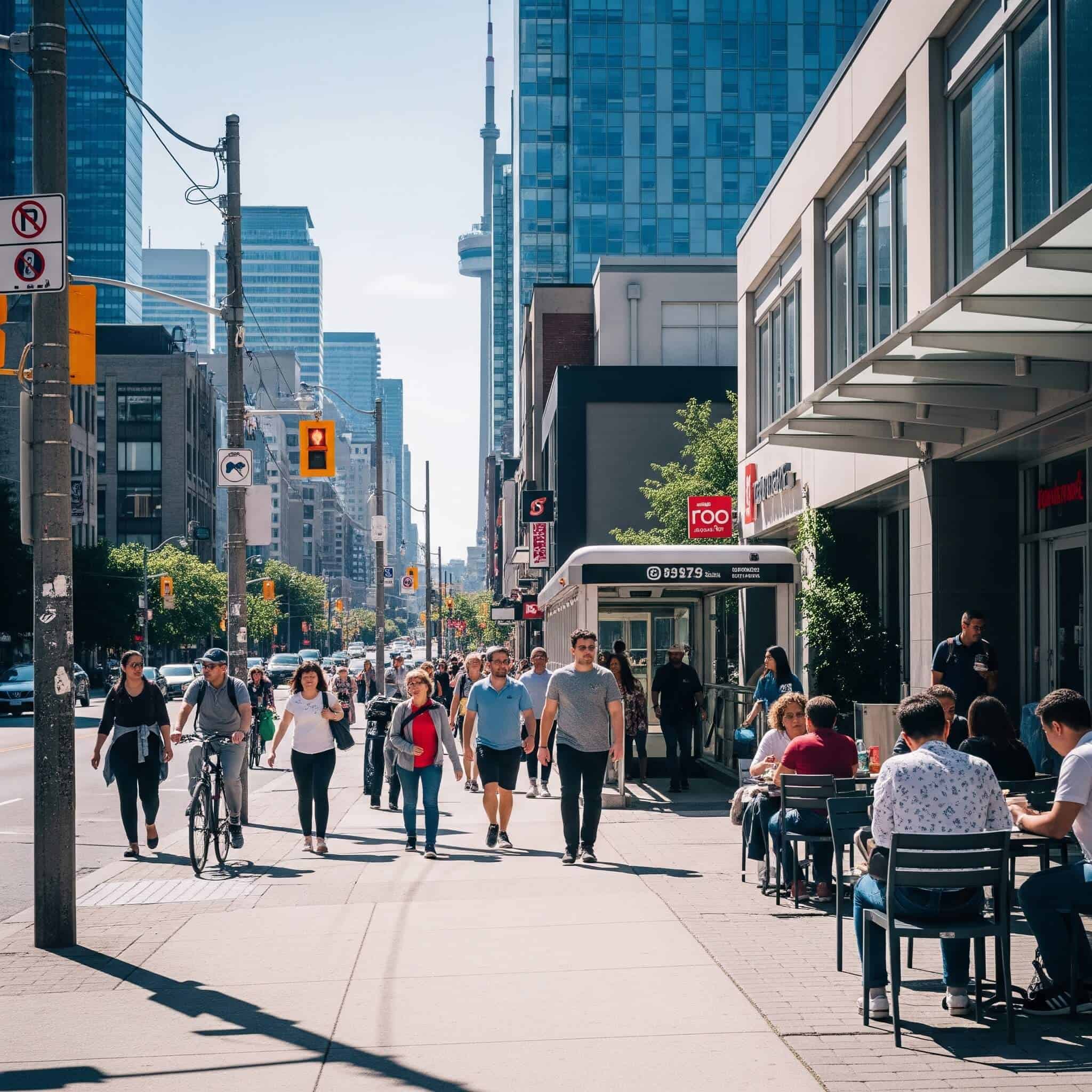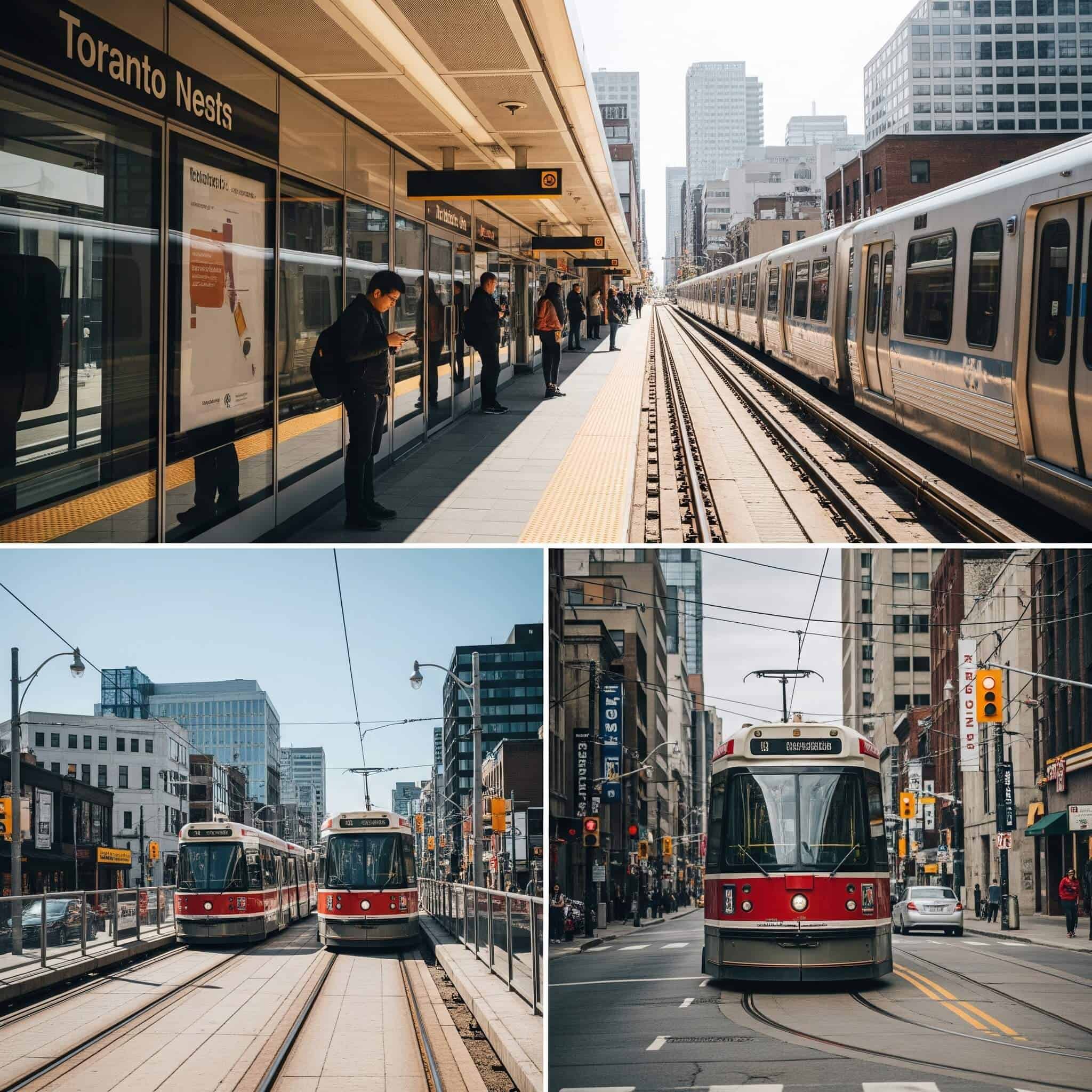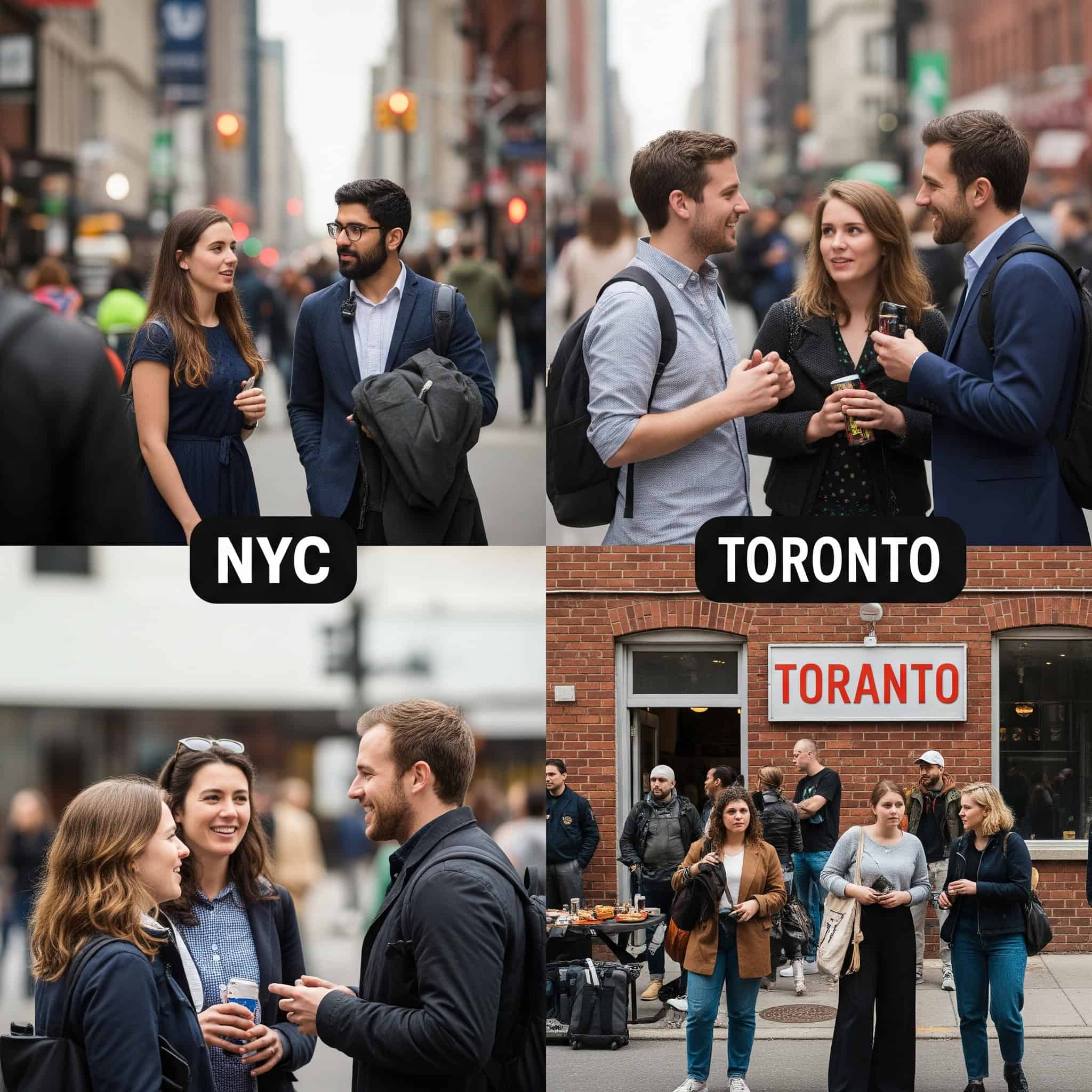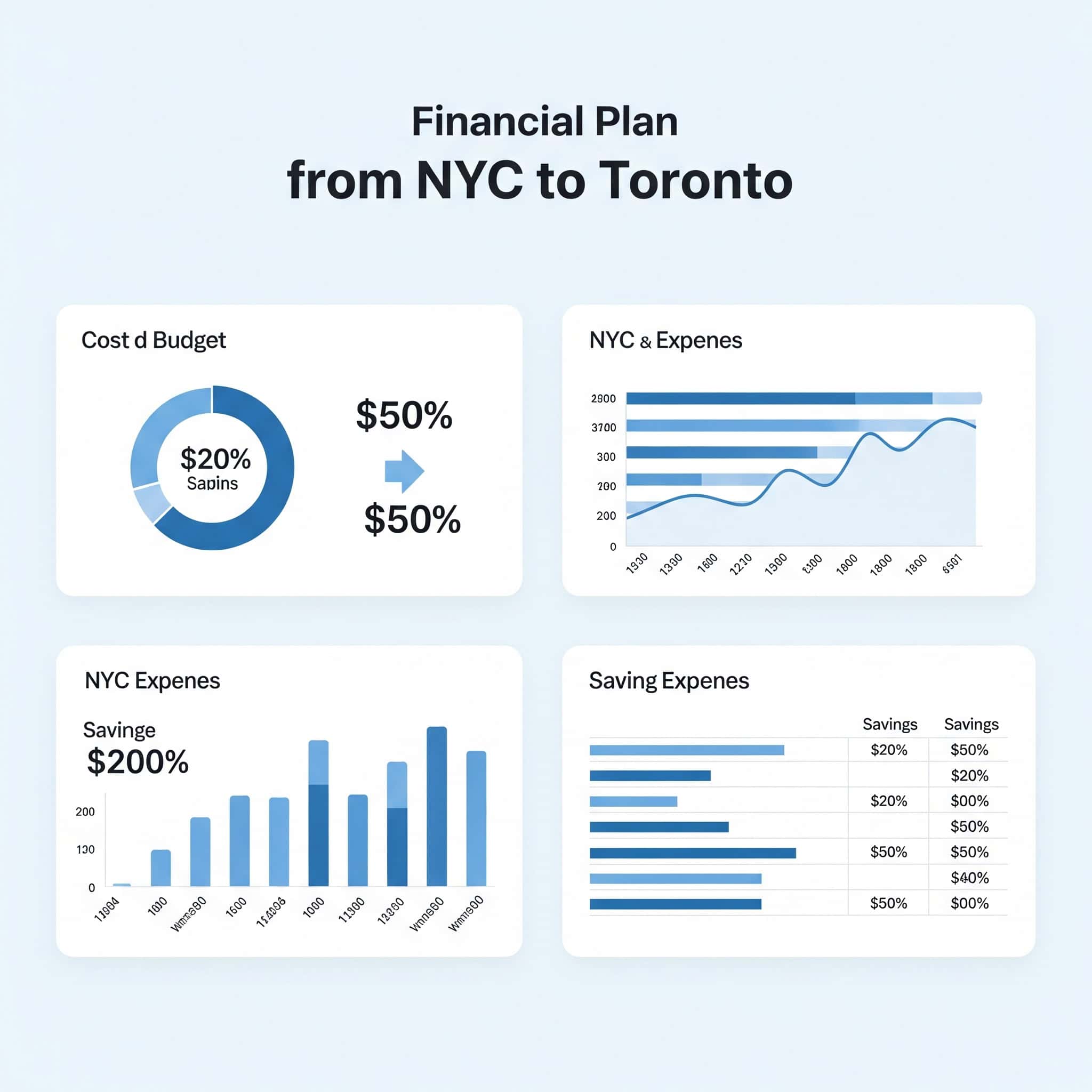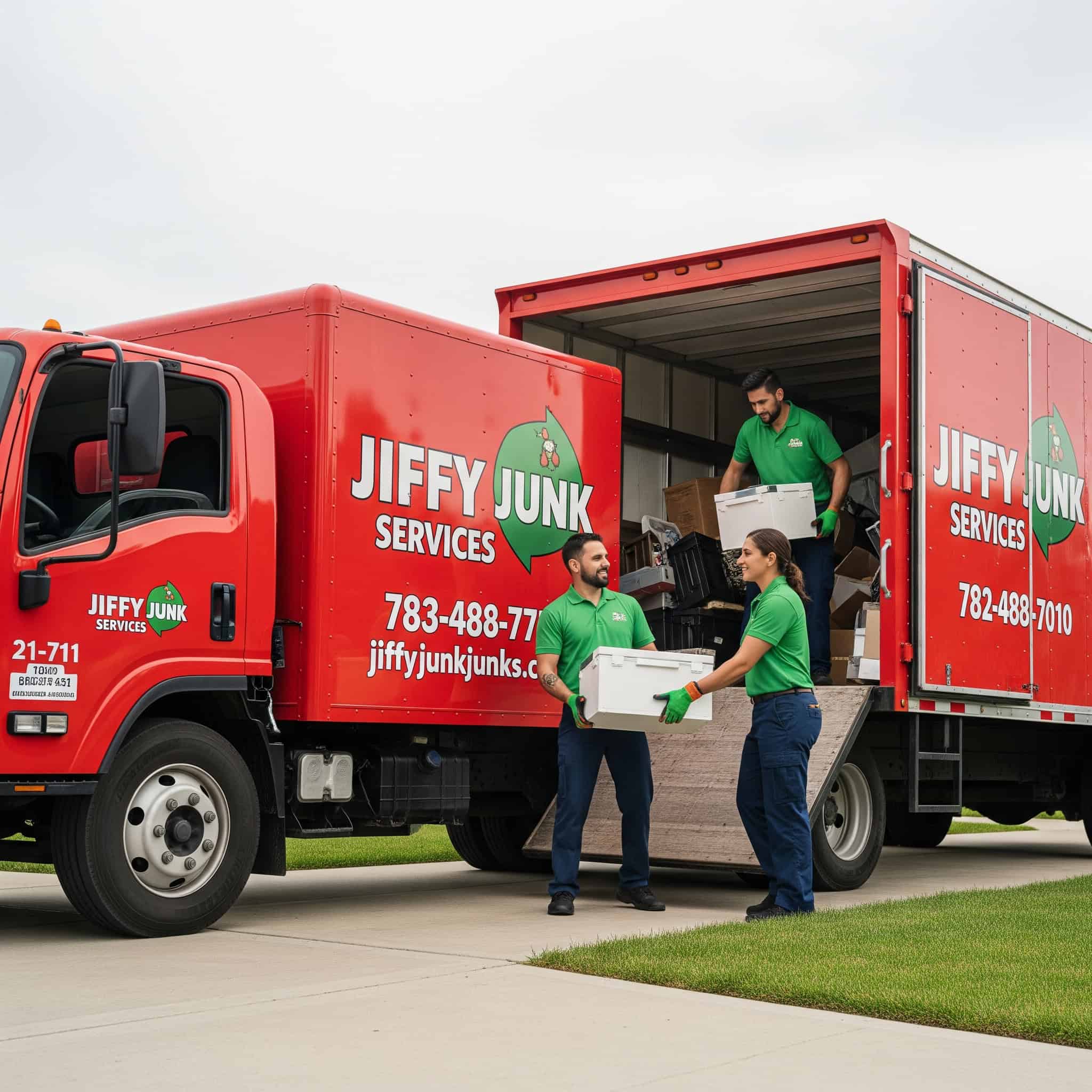NYC to Toronto Relocation Guide: 25 Essential Aspects for a Smooth International Move
Table of Contents
Immigration & Legal Requirements
Housing & Neighborhoods
Daily Life & Cultural Adjustment
Financial Planning & Employment
Logistics & Practical Matters
Cultural and Lifestyle Adjustments
Practical Transition Considerations
Long-Term Integration Strategies
How Jiffy Junk Can Help With Your Move
Final Thoughts
Immigration & Legal Requirements
1. Understanding Work Permit Options
Getting a work permit is your first step toward legally working in Canada. I had to figure out which type worked best for my situation – the NAFTA/USMCA Professional visa seemed most straightforward for my field.
Processing times can be all over the place, so don’t wait until the last minute! My colleague applied for her USMCA permit in January and didn’t receive approval until late March, which threw off her entire moving timeline. Each permit has specific eligibility requirements based on your profession and education.
The NAFTA/USMCA work permits need a valid job offer from a Canadian employer and proof you’re qualified in one of the treaty’s listed professions. Processing typically takes 2-8 weeks depending on how busy immigration is.
If you’re transferring within your company, you’ll need at least one year of employment in a specialized knowledge, managerial, or executive role before moving to the Canadian branch. This route can take 4-12 weeks to process, so plan accordingly!
2. Exploring Permanent Residency Pathways
If Toronto’s going to be your long-term home, start investigating permanent residency options right away. I wish I’d started this process earlier! The Express Entry system evaluates you based on factors like age, education, work experience, and language skills.
Provincial Nominee Programs can be easier to qualify for than federal programs, especially if your skills match Ontario’s needs. The Ontario Immigrant Nominee Program has specific streams targeting tech workers, skilled trades, and entrepreneurs that might give you an advantage if you’re in those fields.
Express Entry assigns points on a 1200-point scale with cutoffs typically ranging from 450-500 points for invitations to apply. I scored 472 on my first assessment, which was just enough to make the cut in last month’s draw.
Family sponsorship is another option if you have eligible Canadian relatives who can sponsor you. Each pathway has different processing times and requirements, so research thoroughly before deciding which route to take.
3. Navigating Border Crossing with Belongings
Bringing your stuff to Canada requires serious preparation. You’ll need a detailed inventory of everything with approximate values for Canadian customs. I spent an entire weekend cataloging my belongings – tedious but absolutely necessary!
Personal effects you’ve owned for more than six months are typically duty-free, but certain items face restrictions or duties. Electronics, alcohol, and vehicles have specific import regulations that can trip you up if you’re not prepared.
Form B4 (Personal Effects Accounting Document) must be completed for all personal belongings, with two copies required—one for your port of entry and one for the moving company if applicable. I kept a digital copy on my phone as backup, which saved me when the border agent couldn’t find my paperwork.
Restricted items include certain food products, weapons, some plant materials, and specific consumer products that don’t meet Canadian safety standards. I had to leave my pepper spray behind and donate several houseplants I couldn’t bring across the border.
Sarah, a graphic designer from Manhattan, created a detailed inventory spreadsheet for her move to Toronto, categorizing items by room and including purchase dates and estimated values. For her electronics, she included original receipts and serial numbers. Upon arriving at the border, customs officials quickly processed her paperwork because everything was well-organized and clearly documented. Her thorough preparation saved her from paying unnecessary duties on her professional equipment, as she could prove she had owned her design workstation and tablet for over two years.
4. Understanding Tax Implications
Your move creates tax obligations in both countries – something I wasn’t fully prepared for my first year. As a US citizen, you must continue filing US tax returns regardless of where you live. The US-Canada tax treaty helps prevent double taxation, but you need to understand foreign income exclusions, tax credits, and reporting requirements.
The Foreign Earned Income Exclusion allows US citizens to exclude up to $112,000 (2022 figure) of foreign earnings from US taxation if they meet either the physical presence test or bona fide residence test. This saved me thousands in my first year as a Canadian resident.
FBAR filing is required for US persons with foreign financial accounts exceeding $10,000 at any point during the calendar year, with substantial penalties for non-compliance. I set a calendar reminder to complete this form every April to avoid issues.
Your residency status in Canada determines your tax liability there, with different rules for part-year residents during your transition year. I found working with a cross-border tax specialist worth every penny during my first Canadian tax season.
5. Managing Banking and Financial Transition
Your US credit history doesn’t automatically transfer to Canada, which was one of the most frustrating parts of my move. You’ll essentially start from scratch, but major Canadian banks offer newcomer packages designed to help establish banking presence without local credit history.
Newcomer banking packages typically waive monthly fees for 6-12 months and may include free international money transfers, no-fee credit cards, and safety deposit boxes. I went with TD Bank’s newcomer package since they have branches in both countries, which made transferring funds much easier.
You’ll need to open Canadian accounts, obtain a local credit card, and potentially maintain US accounts for ongoing obligations. I kept my Chase account active for my US credit card payments and subscription services that only accept US payment methods.
The NEXUS program ($50 for five years) expedites border crossings and can be valuable for maintaining connections between the US and Canada if you’ll travel frequently. I applied for my NEXUS card three months before moving and it’s been incredibly useful for visits back to New York.
Housing & Neighborhoods
6. Selecting the Right Toronto Neighborhood
Toronto’s neighborhoods each have distinct personalities, amenities, and price points that make them unique. When I first visited, I was surprised by how different the vibe was from one area to the next.
Liberty Village attracts young professionals with its urban feel, while Leslieville offers a more relaxed atmosphere with family amenities. Your neighborhood choice affects your commute, lifestyle, and budget in significant ways. I initially wanted to live downtown but ended up in the Annex, which gave me a better quality of life for my budget.
The PATH system—Toronto’s underground pedestrian network—connects 30 kilometers of shopping, services, and entertainment, providing weather-protected access to downtown locations and influencing desirability of connected residential buildings. During winter, having PATH access from my office building saved me from trudging through snow and slush.
Property tax rates in Toronto (approximately 0.61% of assessed value) are significantly lower than NYC (around 0.88%), affecting long-term housing costs. This difference adds up substantially if you’re planning to buy property.
7. Navigating Toronto’s Rental Market
Toronto’s rental market operates differently from NYC’s, which caught me off guard when I started apartment hunting. Landlords typically require first and last month’s rent upfront, employment verification, and references.
The application process moves quickly in competitive areas. I lost two apartments because I wasn’t prepared to make a decision on the spot. Have your documents ready and be prepared to apply immediately if you find a place you like.
Ontario’s standard lease form became mandatory in 2018, providing a standardized template that landlords must use, making it easier to understand your rights and obligations. This was actually a relief compared to the varied lease agreements I’d seen in New York.
The Landlord and Tenant Board handles disputes, with filing fees of $53-$190 depending on the application type, providing a more accessible resolution system than NYC’s housing court. Knowing your rights as a tenant is crucial – I recommend reading through the Residential Tenancies Act before signing any lease.
Rent control applies to buildings occupied before November 2018, limiting annual increases, but newer buildings have no such protections. I specifically looked for rent-controlled buildings to avoid surprise increases down the road.
For those concerned about leaving furniture behind during your move, understanding your options is important. Many New Yorkers find themselves wondering about the best approaches for furniture disposal in NYC and beyond, which can help streamline your relocation process.
8. Understanding Home Buying Differences
If you’re considering purchasing property, Canadian mortgage qualification differs from US practices. You’ll need a minimum 5% down payment for homes under $500,000, with higher percentages required for more expensive properties.
Mortgage stress testing requires borrowers to qualify at either the benchmark rate of 5.25% or their contract rate plus 2%, whichever is higher, regardless of their actual interest rate. This means you might qualify for less house than you expected based on your income.
Foreign buyers face additional considerations, including the Non-Resident Speculation Tax in the Greater Toronto Area. This tax adds significant costs if you’re not yet a permanent resident or citizen.
Land transfer tax in Toronto is doubled because buyers pay both municipal and provincial taxes, ranging from 0.5% to 2.5% of property value, significantly increasing closing costs. When I bought my condo, the land transfer taxes added nearly $15,000 to my closing costs!
Closing costs, home inspection practices, and bidding processes also differ from NYC norms. I was surprised that many Toronto buyers waive home inspections to make their offers more competitive – a practice I wasn’t comfortable with.
9. Setting Up Utilities and Services
Establishing essential services in your new Toronto home requires advance planning. I learned this the hard way when I moved in January and had to wait five days for internet installation!
You’ll need accounts with Toronto Hydro for electricity, Enbridge for natural gas, and providers like Rogers or Bell for internet and TV. Some utilities require deposits for newcomers without Canadian credit history. I had to pay a $500 deposit for my electricity account that was refunded after a year of on-time payments.
The Ontario Energy Board regulates electricity rates with time-of-use pricing that charges different rates depending on when you use electricity (off-peak, mid-peak, and on-peak hours). I adjusted my habits to run my dishwasher and laundry during off-peak hours, which saved me about 30% on my electricity bills.
Internet service providers often require 1-2 year contracts with early termination fees, unlike some NYC providers that offer month-to-month options. Read the fine print carefully before signing up for any services.
Service connection times vary, so schedule setups well before your arrival date to avoid living without essentials. I recommend arranging utilities at least two weeks before your move-in date.
10. Preparing for Winter Housing Considerations
Toronto winters demand specific housing preparations beyond what you’re accustomed to in NYC. I was shocked by my first heating bill until I weatherproofed my windows and doors!
Ensure your home has adequate insulation, efficient heating systems, and potentially snow removal services. Utility costs spike significantly during winter months, affecting your housing budget. My January heating bill was triple my September bill, which I hadn’t budgeted for.
R-values (thermal resistance measurements) for insulation should be R-50 to R-60 for attics and R-22 to R-24 for walls in Toronto’s climate zone for optimal energy efficiency. When apartment hunting, I started asking about insulation values after my first winter experience.
Heat Recovery Ventilators (HRVs) are common in newer Toronto homes, recovering 55-75% of heat from exhaust air while providing fresh air ventilation—a feature rarely found in NYC apartments. My newer condo has this system, and it makes a noticeable difference in both comfort and energy bills.
Drafty windows, insufficient insulation, or outdated heating systems can make winter uncomfortable and expensive. These factors should influence your housing selection more than they might have in NYC.
Daily Life & Cultural Adjustment
11. Navigating the Healthcare System
Ontario’s healthcare system operates fundamentally differently from what I was used to in the US. The biggest shock was not having to pull out my credit card after doctor visits!
New residents face a three-month waiting period before Ontario Health Insurance Plan (OHIP) coverage begins, requiring private insurance during this gap. I purchased a six-month policy to be safe, which cost about $900 but gave me peace of mind.
OHIP coverage requires proof of residency status and physical presence in Ontario for at least 153 days in any 12-month period to maintain eligibility. Keep track of your travel days outside the province if you plan to visit the US frequently.
The Health Care Connect program helps match patients with family doctors accepting new patients, though wait times in Toronto average 4-6 months for non-urgent placements. I registered immediately upon arrival but still waited five months to get assigned to a family doctor.
Once covered, most essential medical services have no direct cost, but prescription medications, dental care, and vision services typically aren’t included. Many employers offer supplemental insurance to cover these gaps.
Michael, a software developer from Brooklyn, moved to Toronto with his family in February. He purchased a six-month private health insurance policy to cover their needs during the OHIP waiting period. In March, his daughter developed a persistent cough, and they visited a walk-in clinic. The clinic charged $80 for the visit, which their private insurance reimbursed. By May, they had received their OHIP cards, and Michael used Health Care Connect to find a family doctor accepting new patients. Though they waited three months for their first appointment, all subsequent visits were fully covered with no co-pays or deductibles—a welcome change from their US healthcare experience.
12. Adapting to Public Transportation Differences
Toronto’s public transit system consists of subways, streetcars, and buses, with the Presto card serving as the payment method. I found the system comprehensive but definitely different from NYC’s subway-centric network.
While extensive, Toronto’s system has fewer subway lines and less frequent service than NYC’s, especially late at night. I was surprised when I discovered the subway closes around 1:30 am on weekends – quite different from NYC’s 24/7 service!
The TTC’s two-hour transfer window allows unlimited travel in any direction within that timeframe, unlike NYC’s largely one-way transfer system. This feature saved me money when running multiple errands across the city.
GO Transit provides regional rail and bus service throughout the Greater Toronto Area with zone-based fares ranging from $3.70 to $12.45, connecting Toronto to surrounding communities. I use GO trains for weekend trips to nearby cities like Hamilton and Niagara Falls.
Learning neighborhood bus routes often becomes more important than in NYC. I rarely took buses in Manhattan but found myself relying on them heavily in Toronto, especially during winter when I wanted to minimize walking in the cold.
13. Managing Driving and Car Ownership
You’ll need to exchange your US driver’s license for an Ontario license within 60 days, with different processes depending on which state issued your original license. I was able to swap my New York license directly for an Ontario G license without taking any tests, which was a pleasant surprise.
Ontario uses a graduated licensing system with G1 (learner), G2 (intermediate), and G (full) licenses, but experienced US drivers can typically skip directly to a G2 or G license depending on driving history. The process at DriveTest centres can be time-consuming, so schedule your appointment well in advance.
Auto insurance rates in Toronto rank among Canada’s highest, often surprising newcomers from NYC. My insurance quote was nearly double what I paid in New York for the same coverage! Shopping around with multiple brokers saved me about 30%.
Winter tires, while not legally mandated in Ontario (unlike Quebec), provide significantly improved safety and may qualify for insurance discounts of 2-5%. I invested in a good set my first winter and they made driving in snow much less stressful.
Parking regulations, especially winter parking rules during snow clearing operations, differ significantly from NYC practices. I got two parking tickets my first month because I didn’t understand the overnight street parking restrictions during snowstorms.
When moving to Toronto, you might find yourself needing to dispose of your current vehicle if it’s older or not worth importing. Jiffy Junk’s scrap metal pickup services can help with vehicle parts and other metal items you decide not to bring along.
14. Transitioning Educational Systems
Toronto offers public, Catholic (publicly funded), and private school options, with enrollment typically based on catchment areas for public schools. I was surprised to learn that Catholic schools receive public funding but maintain their religious identity.
The Toronto District School Board (TDSB) is North America’s largest school board, serving approximately 247,000 students across 583 schools with specialized programs including French immersion, arts-focused curricula, and International Baccalaureate. The variety of specialized programs impressed me compared to what was available in NYC.
School calendars and grade structures differ from New York’s system. The school year typically runs from early September to late June, with a two-week break at Christmas and a one-week spring break, usually in March.
Ontario’s standardized testing occurs in grades 3, 6, 9, and 10 through the Education Quality and Accountability Office (EQAO), with results influencing school choice for many families. These test results are publicly available and can help you evaluate potential schools.
If moving with children, you’ll need to gather academic records, understand grade placement procedures, and research school registration deadlines. I recommend contacting potential schools at least three months before your planned move to ensure a smooth transition.
15. Adjusting to Shopping and Consumer Differences
Retail experiences in Toronto differ from NYC in several ways. You’ll find Canadian chains replacing familiar US stores, different product brands, and variations in consumer protection laws. My first grocery shopping trip was disorienting – so many unfamiliar brands!
Harmonized Sales Tax (HST) in Ontario combines federal and provincial taxes at 13%, applying to most purchases but with notable exceptions including basic groceries and children’s clothing. Unlike NYC, the price you see on the shelf is not the price you pay at checkout, which took some getting used to.
The Competition Bureau enforces Canadian pricing accuracy laws requiring retailers to provide items free (up to $10) or with a $10 discount (for items over $10) if scanner prices exceed the displayed price. I’ve received several free items thanks to this policy when stores made pricing errors.
Grocery shopping introduces new chains, house brands, and product packaging. I missed Trader Joe’s terribly until I discovered Nations Fresh Foods and T&T Supermarket, which have become my go-to stores for interesting food finds.
Understanding measurement differences (metric system) and terminology variations helps smooth your shopping transition. I still catch myself converting temperatures from Celsius to Fahrenheit and kilometers to miles in my head.
Financial Planning & Employment
16. Budgeting for Cost of Living Adjustments
Toronto’s expense structure differs from NYC’s in important ways. While housing costs are generally lower, food costs can be higher, and you’ll encounter new expenses like potentially higher cell phone plans.
The “pink tax” on imported US products can increase costs by 10-30% on identical items due to import duties, distribution inefficiencies, and market size differences. I was shocked when I found my favorite shampoo for nearly double the US price!
Currency exchange spreads at banks typically range from 2.5-3.5%, while specialized services like Wise or OFX offer rates closer to 0.5-1%, significantly impacting large transfers. I saved over $2,000 on my initial money transfer by using Wise instead of my bank.
The exchange rate between USD and CAD affects your purchasing power, especially if you maintain income or assets in US dollars. I track exchange rate trends and try to transfer larger amounts when the rate is favorable.
Creating a realistic budget that accounts for these differences prevents financial stress during your transition. I recommend tracking every expense for your first three months to identify unexpected costs and adjust your budget accordingly.
17. Researching Toronto’s Job Market
Toronto’s employment landscape features strong finance, technology, film production, and healthcare sectors. I found the job market more relationship-driven than NYC’s – networking proved crucial to landing my position.
The Toronto Global Forum and MaRS Discovery District serve as innovation hubs connecting job seekers with emerging opportunities in fintech, cleantech, and health technology sectors. Attending events at these venues helped me build my professional network quickly.
Regulated professions in Ontario require recognition through field-specific bodies like the Professional Engineers Ontario or College of Nurses, with assessment processes taking 3-12 months depending on the profession. A friend who’s a nurse had to complete additional coursework before she could practice in Ontario.
Competition and qualification requirements differ from NYC, with some professions requiring Canadian certification or licensing. I was surprised to learn that even with my years of US experience, some employers were hesitant without Canadian work history.
Networking practices, interview expectations, and resume formats follow Canadian conventions. Canadian resumes typically don’t include photos, and they’re called “CVs” more often than in the US. I had to revise my resume significantly to match Canadian expectations.
18. Setting Realistic Salary Expectations
While Toronto salaries are competitive for Canada, they may be lower than equivalent positions in NYC. I took about a 15% pay cut when I moved, but my overall quality of life improved thanks to lower housing costs and healthcare savings.
Statutory vacation minimums in Ontario start at two weeks annually, increasing to three weeks after five years with the same employer, compared to NYC’s lack of mandated vacation time. This additional time off has been a welcome change from my previous job’s stingy vacation policy.
Employer pension contributions to group Registered Retirement Savings Plans (RRSPs) or defined contribution plans typically range from 3-6% of salary, creating significant long-term value. My employer matches my RRSP contributions up to 4%, which effectively increases my compensation.
Canadian employers typically offer fewer health benefits (as basic healthcare is covered) but potentially more vacation time. Dental and vision coverage is still commonly provided by employers, along with disability insurance and life insurance.
Understanding typical compensation packages in your field helps with negotiation and financial planning. I researched salary ranges on sites like Glassdoor and PayScale specifically for Toronto before my interviews, which helped me negotiate effectively.
19. Adjusting Retirement Planning
Your international move significantly impacts retirement planning. I spent hours researching what to do with my 401(k) and Roth IRA after moving to Canada.
The US-Canada tax treaty allows for tax-deferred status of retirement accounts, but RRSPs must be reported annually to the IRS on Form 8891 to maintain tax-deferred status. Missing this filing requirement can create tax headaches, as I discovered when I had to file amended returns for my first year in Canada.
The Canada Pension Plan (CPP) requires 39 years of maximum contributions for full benefits, with international social security agreements potentially allowing combination of US and Canadian work credits. This means your US Social Security contributions aren’t “wasted” even if you retire in Canada.
You’ll need to decide whether to maintain US retirement accounts like 401(k)s or potentially roll them into Canadian equivalents like RRSPs. I chose to keep my US accounts intact but stopped contributing to them, focusing instead on building my Canadian retirement savings.
Cross-border retirement planning is complex and usually requires specialized financial advice to optimize tax efficiency. The fee I paid for a consultation with a cross-border financial planner was worth every penny for the peace of mind it provided.
20. Developing a Currency Management Strategy
Managing two currencies requires planning to minimize exchange costs and maximize flexibility. I learned this lesson the hard way after losing hundreds of dollars to poor exchange rates and bank fees my first few months.
Forward contracts allow locking in exchange rates for future transfers, protecting against currency fluctuations when planning major expenses like home purchases. I used this strategy when saving for my down payment, which protected me when the Canadian dollar weakened against the USD.
Norbert’s Gambit—buying interlisted stocks on one exchange and selling on another—can save substantial fees when converting large sums between USD and CAD, typically reducing costs to under 0.5%. This technique saved me over $1,000 when transferring my house down payment.
Consider maintaining US and Canadian bank accounts, with strategic transfers based on exchange rates. I use TD Bank’s cross-border banking package, which makes transfers between my US and Canadian accounts relatively seamless.
Regular currency conversion can incur significant fees; services like Wise or OFX may offer better rates than traditional banks. I set up alerts to notify me when exchange rates hit favorable levels, allowing me to time larger transfers for maximum value.
Logistics & Practical Matters
21. Selecting International Moving Services
Cross-border relocation requires specialized moving services familiar with customs documentation and border procedures. I interviewed five different moving companies before finding one with extensive US-Canada experience.
Form B4 and Form B6 must be completed for personal effects and vehicles respectively, with detailed inventories required for customs clearance. My mover provided templates for these forms, which saved me hours of research and potential mistakes.
Bonded moving companies can transport sealed containers across the border without inspection at crossing points, with customs clearance occurring at the destination, potentially saving significant time. This feature was worth the extra cost for the peace of mind it provided.
Companies specializing in US-Canada moves can handle paperwork and ensure compliance with regulations. The company I chose took care of all customs documentation, which removed a huge source of stress from my move.
Moving quotes should include customs clearance services and potential storage during transition periods. I needed temporary storage when my apartment wasn’t ready on time, and having this included in my moving package saved me from scrambling to find a solution.
Jessica, a marketing executive relocating from Queens to Toronto, received quotes from three international moving companies. The lowest bid seemed attractive but didn’t include customs brokerage services. The mid-range company offered a comprehensive package with door-to-door service, customs clearance, 30 days of storage, and a guaranteed delivery window. Though it cost $1,800 more than the lowest quote, Jessica chose this option. When her work permit was delayed by three weeks, the included storage prevented additional fees, and the mover’s customs expertise helped avoid duties on her home office equipment by properly documenting it as business tools she had owned for years.
Before your international move, you might want to consider decluttering your home to reduce moving costs and start fresh in Toronto. A systematic approach to sorting through your belongings can make your relocation significantly more manageable.
22. Timing Your Relocation Strategically
The timing of your move affects costs, convenience, and comfort. I moved in April, which gave me time to settle in before winter and avoided the peak summer moving season.
Toronto’s rental market typically sees highest turnover on July 1 and September 1, with approximately 15-20% more listings available but also increased competition during these periods. I found starting my apartment search in March gave me more negotiating power with landlords eager to secure tenants.
Moving cost differentials between peak (June-August) and off-peak seasons can reach 20-30%, with mid-month moves typically offering better availability and rates than month-end dates. My mid-April move saved me nearly $2,000 compared to quotes for June.
Winter relocations present challenges with weather and road conditions, while summer is peak moving season with higher costs. A friend who moved in January faced weather delays and slippery conditions that made unloading furniture dangerous.
Aligning your move with lease terms, school calendars, and immigration timelines requires careful coordination. I created a detailed timeline working backward from my job start date to ensure everything aligned properly.
23. Understanding Pet Relocation Requirements
Bringing pets to Canada requires preparation and documentation. My cat needed an updated rabies vaccination and health certificate before we could cross the border.
Health certificates for pets must be issued by a USDA-accredited veterinarian and endorsed by your state’s USDA APHIS Veterinary Services office within 30 days of crossing. Getting this endorsement took longer than expected – allow at least two weeks for processing.
Ontario’s Dog Owners’ Liability Act prohibits pit bull terriers, Staffordshire bull terriers, American Staffordshire terriers, American pit bull terriers, and dogs matching their physical characteristics. Check this list carefully if you have a dog that might be affected.
Dogs and cats typically need rabies vaccinations and health certificates issued within a specific timeframe before entry. My vet recommended updating all vaccinations before moving to ensure we wouldn’t have issues at the border.
Certain dog breeds face restrictions in Ontario, and apartment buildings may have pet policies different from what you experienced in NYC. I had to provide my cat’s veterinary records and pay a pet deposit for my Toronto apartment, which wasn’t required in my NYC building.
24. Managing Technology and Service Transfers
Your move affects digital services, subscriptions, and technologies. I was disappointed to discover that my Hulu subscription wouldn’t work in Canada, and my smart thermostat needed reconfiguration for Celsius.
CRTC regulations require cell phones sold after December 2017 to be unlocked, allowing use with any carrier, but band compatibility issues may limit functionality of some US phones on Canadian networks. My iPhone worked fine, but a friend’s Android phone couldn’t connect to certain network bands.
VPN services can provide access to US-based content libraries and services, with annual subscriptions ranging from $40-120 depending on features and security levels. I use NordVPN to access my US streaming services and banking websites that sometimes block international access.
Some US streaming services have different content libraries in Canada, and certain smart home devices may need reconfiguration. Netflix and Amazon Prime Video required me to create new Canadian accounts, which meant losing my viewing history and recommendations.
Cell phone plans in Canada are generally more expensive than in the US, and you’ll likely need to switch to a Canadian provider. I was shocked when my first Canadian cell phone bill was nearly double what I paid in New York for less data!
When setting up your new Toronto home, you may need to dispose of outdated electronics that aren’t compatible with Canadian systems. Understanding electronics recycling options can help you responsibly manage these items during your transition.
25. Building a Support Network
Establishing social connections in Toronto requires proactive effort. I found this challenging at first, coming from NYC where my social circle had developed organically over years.
The American Women’s Club of Toronto, American Chamber of Commerce, and Democrats Abroad maintain active chapters providing both social connections and practical support for newcomers. These groups were invaluable for meeting people who understood the transition I was experiencing.
Toronto Public Library offers free newcomer settlement services including employment resources, language practice groups, and community information sessions at 100 branches throughout the city. I attended several workshops that helped me understand Canadian workplace culture.
Join expatriate groups, professional associations, or neighborhood organizations to build relationships. I joined a running club and a professional marketing association, which quickly expanded my social circle.
Toronto’s social culture differs from NYC’s, with potentially less spontaneous interaction but strong community groups and organized activities. I found Torontonians friendly but more reserved than New Yorkers – building relationships takes more time but results in solid friendships.
Cultural and Lifestyle Adjustments
Understanding Social Etiquette Variations
Toronto social norms differ subtly from NYC’s direct communication style. The first time someone apologized to me when I bumped into them, I was confused!
Canadian workplace communication typically emphasizes consensus-building and collaborative language, with direct criticism often delivered using the “feedback sandwich” approach. In meetings, I’ve had to tone down my direct New York style to avoid coming across as aggressive.
You’ll notice more frequent use of “sorry” and “thank you” in everyday interactions. Studies show Canadians say “sorry” approximately 8 times per day on average, often as a conversation facilitator rather than an admission of fault. I’ve caught myself adopting this habit after just a few months here.
While New Yorkers value straightforward communication, Canadians often employ more diplomatic language, even in professional settings. My first performance review in Toronto was so politely worded that I initially missed some important constructive criticism!
These differences extend to business meetings, email communication, and conflict resolution approaches. Adapting your communication style helps build stronger relationships in your new home.
Embracing Toronto’s Multicultural Landscape
Toronto’s population includes over 50% of residents born outside Canada, creating distinct ethnic enclaves worth exploring. The diversity here makes NYC look homogeneous by comparison!
Toronto hosts over 200 ethnic festivals annually, including Caribana (North America’s largest Caribbean festival), Taste of the Danforth (Greek), and TD Salsa on St. Clair, reflecting the city’s cultural diversity. I’ve made it a point to attend at least one new cultural festival each month.
The city officially recognizes 180 languages and dialects spoken by residents, with 45% of Torontonians speaking a mother tongue other than English or French. You’ll hear dozens of languages just riding the subway or walking through neighborhoods like Kensington Market.
From Little Italy to Greektown, Chinatown, Little Jamaica, and Koreatown, each neighborhood offers authentic cultural experiences. I’ve discovered amazing Ethiopian restaurants, Polish bakeries, and Korean skincare shops that I never would have found in my NYC neighborhood.
This diversity influences everything from food options to festivals, religious observances, and business practices. Engaging with this multicultural environment enriches your Toronto experience.
Developing Weather Adaptation Strategies
Toronto winters demand serious preparation beyond what NYC requires. My first winter here was a shock to my system!
Toronto averages 121.5 cm (47.8 inches) of snowfall annually compared to NYC’s 64.4 cm (25.3 inches), with snow typically remaining on the ground from December through March. In NYC, snow often melts within days; in Toronto, it sticks around for months.
Wind chill factors regularly push perceived temperatures 10-15°C lower than actual readings, making proper layering with moisture-wicking base layers, insulating mid-layers, and windproof outer shells essential. I invested in quality merino wool base layers that made a huge difference in my comfort.
Investing in proper winter gear becomes essential—quality boots with good traction, layering systems, and winter coats rated for subzero temperatures will become wardrobe staples. My $300 investment in proper winter boots was the best money I spent my first year here.
Learning winter driving techniques, home maintenance practices, and outdoor activity options helps you embrace rather than endure the season. I took up cross-country skiing and discovered it’s a wonderful way to enjoy winter parks.
Practical Transition Considerations
Transferring Healthcare Documentation
Gather complete medical records before departing NYC, as transferring health information across international systems can be challenging. I created a medical binder with all my records that proved invaluable during my first Canadian doctor visit.
Canadian physicians typically require complete medical history before accepting new patients, with records transfer authorization forms available from the College of Physicians and Surgeons of Ontario. Having these forms ready to go speeds up the process of establishing care.
Request digital copies when possible and consider scheduling final check-ups with specialists before leaving. I had my dentist, optometrist, and primary care doctor all create summary letters of my health status and treatment history.
Prescription medications may have different names, dosages, or availability in Canada, requiring physician review and potential adjustments to treatment plans. My allergy medication had a completely different name in Canada, which created confusion until my pharmacist helped identify the equivalent.
Establishing new healthcare relationships in Toronto takes time due to referral requirements and potential wait times for specialists. Maintaining prescription continuity requires planning with both US and Canadian healthcare providers.
Daniel, an architect with a chronic health condition, created a comprehensive medical portfolio before leaving Manhattan. He requested his complete records from his primary physician and three specialists, had his prescriptions documented with generic names and dosages, and scheduled a telehealth consultation with a Toronto healthcare provider recommended by his NYC doctor. Upon arrival, he discovered that one of his medications was unavailable in Canada, but because he had brought a three-month supply and had detailed documentation, his new Canadian doctor was able to prescribe an appropriate alternative with minimal disruption to his treatment plan. Daniel’s preparation prevented a potential health crisis during his transition period.
Obtaining Professional Credential Recognition
Many professions require Canadian certification or equivalency assessments. I was lucky that my field doesn’t require formal certification, but friends in regulated professions faced significant hurdles.
The World Education Services (WES) provides Educational Credential Assessments recognized by most regulatory bodies, with processing times of 7-20 business days and fees starting at $220 CAD. Getting this assessment before you move can save valuable time in your job search.
Bridging programs offered through organizations like the Toronto Region Immigrant Employment Council (TRIEC) provide profession-specific training to help internationally trained professionals meet Canadian standards. A friend who’s an engineer completed a three-month bridging program that helped her secure employment in her field.
Engineers, teachers, healthcare professionals, and legal practitioners should research their profession’s regulatory body in Ontario well in advance. Some fields require additional coursework or examinations before you can practice.
Understanding these requirements before your move prevents career disruptions and allows for advance preparation. When moving from New York to Toronto, professionals should research credential recognition requirements at least 6-12 months before relocating to allow time for any necessary additional certifications or examinations.
Strategically Building Credit History
Since US credit history doesn’t transfer to Canada, you’ll need to build Canadian credit from scratch. This was one of the most frustrating aspects of my move – despite having excellent US credit, I was treated as a credit risk in Canada.
Credit bureaus Equifax and TransUnion operate in both countries but don’t share data across borders, requiring manual submission of US credit reports as supporting documentation for some financial applications. I provided my US credit reports when applying for my first Canadian credit card, which helped me get approved.
Secured credit cards typically require security deposits of $500-1,000, with graduation to unsecured products possible after 12-18 months of responsible use. I started with a secured card that required a $1,000 deposit but was able to upgrade to an unsecured card after 10 months of on-time payments.
Beyond newcomer banking packages, secured credit cards provide a starting point. Some Canadian American Express cardholders can leverage their US history through the Global Transfer program, which I wish I’d known about before applying for other cards.
Establishing utility accounts, cell phone plans, and rental history in your name also contributes to credit building. I made sure all services were in my name and paid everything on time, which helped establish my Canadian credit profile.
Implementing Cross-Border Mail Management
USPS mail forwarding doesn’t work internationally, requiring alternative solutions. This caught me by surprise – I naively assumed I could just forward my mail to Canada!
Virtual mailbox services like US Global Mail or Earth Class Mail provide physical US addresses with mail scanning, forwarding, check deposit, and package receiving services for $10-35 monthly. I use Earth Class Mail and find it well worth the $20 monthly fee for peace of mind.
USPS Premium Forwarding Service forwards all mail weekly to international addresses for $21.90 per shipment plus a $21.90 enrollment fee, offering temporary continuity during transition periods. This service works well for the first few months while you’re updating your address with various organizations.
Consider using a mail scanning service or trusted contact in the US to handle important correspondence during your transition. My sister checks a few pieces of mail that still occasionally go to my old address, which has been helpful for items that slip through the cracks.
Update address information with financial institutions, subscription services, and government agencies. Creating a comprehensive contact list ensures you don’t miss important communications during your move. I created a spreadsheet tracking every organization I needed to notify, which helped me stay organized during the transition.
Long-Term Integration Strategies
Embracing Canadian Identity While Maintaining Your Roots
Finding ways to participate in distinctly Canadian traditions helps with integration while maintaining your New York identity. I’ve embraced hockey night gatherings with neighbors while still cheering for the Yankees during baseball season.
The Institute for Canadian Citizenship offers Cultural Access Pass providing free admission to over 1,400 cultural attractions during your first year as a permanent resident. This program helped me explore Canadian history and culture without breaking the bank.
From celebrating Thanksgiving in October rather than November to understanding the significance of events like Victoria Day, embracing local customs accelerates your sense of belonging. My first Canadian Thanksgiving felt strange in October, but I’ve come to appreciate having two separate holidays for giving thanks!
Dual citizenship becomes possible after meeting Canadian residency requirements (3 years within a 5-year period), allowing maintenance of both US and Canadian passports. I’m tracking my eligibility date and plan to apply as soon as I qualify.
This balanced approach enriches your experience without requiring you to abandon your cultural background. I’ve found that Canadians appreciate when newcomers make efforts to understand and participate in local traditions while sharing their own cultural perspectives.
Optimizing Cross-Border Tax Planning
The US-Canada tax treaty provides specific protections against double taxation, but requires proactive planning. My first cross-border tax return was so complicated that I hired a specialist, but the peace of mind was worth the expense.
IRS Form 8833 (Treaty-Based Return Position Disclosure) must be filed when claiming treaty benefits, with specific reporting requirements for different types of income. Missing this form can result in penalties, even if you’ve paid all required taxes.
The Foreign Tax Credit allows dollar-for-dollar reduction of US tax liability based on taxes paid to Canada, but requires careful allocation between different income categories. This credit has been crucial in preventing double taxation on my Canadian income.
Certain retirement accounts receive special treatment, and tax credits in one country may offset obligations in the other. Understanding these interactions helps maximize your after-tax income.
Working with an accountant specializing in cross-border taxation helps optimize your financial situation and ensures compliance with both systems. The fee I pay for specialized tax preparation is high, but the potential cost of mistakes would be much higher.
Maintaining US Connections While Building Toronto Relationships
Preserving ties to NYC while building your Toronto life creates a balanced transition. I schedule monthly video calls with friends from New York and try to visit at least twice a year.
The NEXUS trusted traveler program ($50 for five years) provides expedited processing at airports and land borders, reducing wait times for frequent US-Canada travelers. Getting NEXUS has saved me countless hours at border crossings and airports.
Digital subscriptions to regional publications like the New York Times offer location-specific content regardless of your physical location, maintaining connection to local news and events. I still read the New York Times daily to stay connected to what’s happening in my former home.
Regular video calls with friends, subscribing to New York news sources, and planning periodic visits help maintain important relationships. Technology makes this easier than ever – I’ve had virtual dinner parties with NYC friends that almost felt like being there in person.
Many former New Yorkers find comfort in connecting with others who’ve made the same move through social media groups and meetups. I joined a “New Yorkers in Toronto” Facebook group that has been a great source of both practical advice and social connections.
As you settle into your Toronto life, you’ll likely encounter different waste management systems than NYC’s. Understanding proper disposal methods is important, and resources like eco-friendly trash removal services can help you maintain environmentally conscious practices in your new home.
Implementing a Dual Banking Strategy
Maintaining accounts in both countries provides flexibility for managing finances across borders. This approach has saved me countless headaches when dealing with ongoing US obligations.
Cross-border banking packages often waive international wire transfer fees (typically $15-50 per transaction) and provide preferential exchange rates up to 0.5% better than standard rates. These savings add up quickly if you transfer money frequently.
TD Bank’s Borderless Plan and RBC’s Cross-Border Banking solutions offer integrated online banking platforms showing both US and Canadian accounts in a single interface. I use TD’s cross-border services and appreciate being able to see all my accounts in one place.
Consider banks with strong cross-border presence like TD or RBC that offer integrated services between their US and Canadian operations. This approach simplifies transfers and provides unified account viewing.
Understanding currency conversion timing and methods helps minimize fees and maximize value. I try to make larger, less frequent transfers rather than multiple small ones to reduce overall fees.
Addressing Language Considerations
While Toronto is predominantly English-speaking, Canada’s official bilingualism means French appears on packaging, official documents, and signage. I was surprised by how much French I encountered in everyday life.
The Official Languages Act requires federal services and packaging to be available in both English and French, with language complaints investigated by the Commissioner of Official Languages. This explains why everything from cereal boxes to government forms contains both languages.
Free French language training is available through the Language Instruction for Newcomers to Canada (LINC) program for permanent residents and protected persons. I took advantage of this program to learn basic French, which has been helpful during trips to Quebec.
Basic French knowledge can be helpful, particularly when traveling to Quebec or working with federal government agencies. During a weekend trip to Montreal, even my limited French vocabulary was appreciated by locals.
Bilingual skills may enhance employment prospects, especially in government positions or companies doing business in Quebec. I’ve noticed that job postings often list French as an asset, even for positions in Toronto.
How Jiffy Junk Can Help With Your Move
International moves are typically priced by volume, making decluttering financially beneficial before relocating. I wish I’d been more ruthless about getting rid of stuff before my move – I paid to transport items I ended up donating in Toronto anyway!
Professional junk removal before moving can reduce international shipping volume by 20-30%, with corresponding cost savings of $500-1,500 for typical household moves. This makes services like Jiffy Junk a smart investment before your international relocation.
Jiffy Junk’s White Glove Treatment helps you efficiently clear unwanted items from your NYC home before your cross-border journey. Their team handles removal of old furniture, broken appliances, and general household clutter, ensuring items are recycled or donated whenever possible.
Jiffy Junk’s sorting and disposal processes divert approximately 60% of collected materials from landfills through donation and recycling channels, supporting environmental sustainability. I appreciate their commitment to responsible disposal rather than simply sending everything to landfills.
This eco-friendly approach reduces your moving costs while ensuring responsible disposal of discarded belongings. Before packing up your NYC apartment, consider scheduling a quick and painless bed bug furniture removal service if you have any concerns about bringing unwanted pests to your new Toronto home.
Ready to simplify your move from NYC to Toronto? Contact Jiffy Junk today for a free consultation on pre-move decluttering services that will make your international relocation smoother and more cost-effective.
Final Thoughts
Moving from NYC to Toronto represents both challenge and opportunity. I’ve been here for two years now, and while there were definitely adjustment periods, I’m happy with my decision to relocate.
Research shows international relocations typically require 6-12 months for full cultural adjustment, with the 3-month mark often representing the most challenging period. This matched my experience – around month three, I hit a homesickness wall that gradually improved as I built more connections in Toronto.
Toronto consistently ranks among the world’s most livable cities, placing 4th in North America and 15th globally in the 2022 Global Liveability Index by the Economist Intelligence Unit. The quality of life here is excellent, with clean streets, low crime rates, and abundant green spaces.
While the logistics require careful planning, the rewards of experiencing life in one of North America’s most diverse and livable cities make the effort worthwhile. By addressing immigration requirements, housing considerations, healthcare transitions, and cultural adjustments proactively, you set yourself up for a successful relocation.
Remember that adjustment takes time—give yourself permission to gradually adapt to your new surroundings while maintaining connections to your New York roots. Some days you’ll miss the energy of NYC, but you’ll also appreciate the unique benefits Toronto offers. Embrace the adventure!

